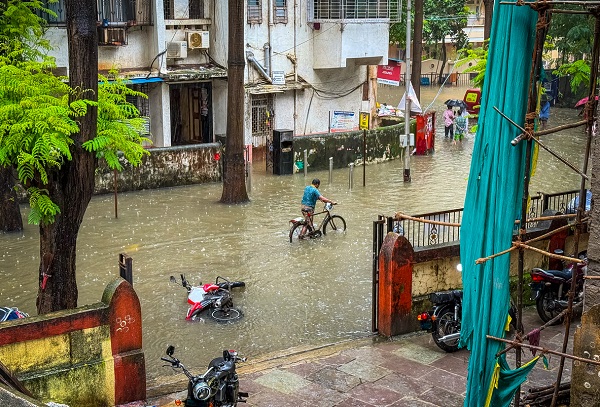.png)

Alok Kumar Mishra is a professor at the University of Hyderabad, researching financial economics and public policy.
August 22, 2025 at 6:31 AM IST
Every monsoon, Mumbai is tested. Streets vanish under brown surges, trains halt, and families wade waist-deep in search of milk and medicines. We call each deluge a once-in-a-century shock, yet the cycle repeats every few years. The truth is more straightforward, and more unsettling: India’s largest city, like many of its peers, is misplanned, underfunded, and poorly managed. Until we change how we finance, design, and govern urban growth, the rains will continue to expose our failures.
For decades, Indian cities have followed a spatial model that encouraged sprawl, mandated rigid land-use segregation, and restricted density through outdated floor space limits. Car-centric planning, long commutes, blocked floodplains, and brittle public transport were the inevitable outcomes. The consequences are visible everywhere: wetlands are sacrificed for real estate, air pollution is choking, rain-swamped cities stretch from Chennai to Bengaluru, and COVID-19 is revealing the fragility of our housing and infrastructure systems.
The irony is that most Indians already walk, cycle, or depend on public transport. Yet cities are designed for motorists. The result is a profound policy mismatch. It is not inevitable. It is a choice we have made.
A better paradigm exists, and it is long overdue. From the 1970s onwards, cities in North America and Europe embraced transit-oriented development, or TOD. Compact, mixed-use, high-density neighbourhoods within a short walk of quality transit became the organising principle of “smart growth.” The logic is compelling. Transit becomes accessible by safe footpaths or cycle lanes, economic clusters thrive around stations, households save on car costs, and rising land values can be recycled to finance transit itself.
Better Paradigm
This is not a rich-world luxury. With its dense population, constrained energy supplies, and urgent climate pressures, India needs TOD more than most.
Mumbai is the obvious starting point. Unplanned expansion and the persistent disconnect between transport and land use have left the city vulnerable to both floods and gridlock. TOD offers a way to align growth with resilience. Imagine renovating old neighbourhoods and directing new development along suburban rail, metro and bus rapid transit corridors. Compact station-area districts, designed with permeable surfaces and blue-green drainage networks, would absorb rather than intensify the impacts of monsoon shocks. Businesses clustered around transit hubs would benefit from deeper labour pools, while households would gain more affordable housing closer to work and services.
The question, as always, is who pays. The answer lies less in new money than in smarter institutions. Every Indian city with a million-plus population should establish a statutory Unified Metropolitan Transport Authority with three simple mandates: plan transit-centred growth, finance it with ring-fenced urban transport funds, and deliver it through coordinated action. Value capture, urban bonds, and accessibility-linked tax increments can help fund projects. Clear zoning around stations, higher floor space, mixed-use, no parking minimums, cycle lanes, and inclusive housing will ensure development supports transit rather than undermines it.
Mumbai Strategy
For Mumbai, the priorities are immediate.
- First, identify a dozen or so stations on the suburban rail and new metro lines with the highest potential for flood resilience, and overlay them with TOD rules.
- Second, map and legally protect the city’s blue-green spine: its lakes, mangroves, and channels, while embedding rain gardens, detention tanks, and permeable paving in every new street design.
- Third, mobilise finance by designating tax increment districts, auctioning joint development rights, and issuing green bonds linked to transit.
- Fourth, make buses reliable and attractive, with feeder lanes, timed transfers, and a single ticket usable across modes.
- And finally, monitor progress with a public dashboard that tracks ridership, travel times, drainage improvements, and financing.
This is not utopian. Hong Kong, Singapore, Bogotá, Curitiba, Copenhagen, London and Portland have all made transit-oriented growth work by pairing clear land-use visions with transit investments, supportive zoning, and creative finance. They focused resources on a few key corridors, proved the model, and then scaled it up. India’s cities can do the same and arguably have an advantage, given our density and travel patterns.
Each year, the monsoon reminds Mumbai what poor planning costs. Resilience cannot be reduced to civic bravery alone; it must be embedded in design, governance and finance. Transit-oriented development is not a slogan. It is a concrete strategy that links mobility with land use, captures value for reinvestment, and builds urban systems able to withstand shocks.
Mumbai has a choice: continue paving, flooding, repairing and repeating, or lead India into a new model of people-centred, climate-resilient growth. The rains will return. The question is whether the city can adapt before it is once again submerged.




